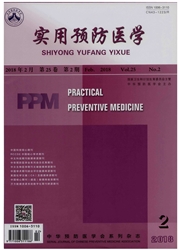

 中文摘要:
中文摘要:
目的 分析南京市城乡居民膳食钠和钾摄入状况及其与血压的相关性。 方法 以多阶段整群随机抽样的方法抽取6个城区1 062户(城市762户,农村300户)18岁及以上居民2 272人,使用连续3 d 24 h膳食回顾法和调味品称重法相结合的方法获得个人膳食钠和钾的摄入量同时进行医学体检获得血压,使用spearman等级相关和多因素logistic回归分析两者的关系。 结果 南京居民每标准人日钠和钾摄入中位数(第25百分位数~75百分位数)分别为4 543.6(3 226.7~6 362.7)mg和1 585.4(1 276.3~2 025.8)mg。实际每日摄入钠3 945.6(2 833.9~5 614.1)mg,钾1 366.6(1 119.2~1 729.1)mg;95.4%的居民膳食钠摄入量超过适宜摄入量(adequate intake,AI),85.3%的居民膳食钾摄入量低于AI值。钠的主要来源是调味品,烹调盐占69.9%,酱油占9.5%;钾主要来源为谷类(21.7%)、蔬菜(32.1%)及肉类(14.3%)。钠钾比值中位数为2.9,其与收缩压和舒张压呈正的等级相关(rs=0.049,P=0.028;rs=0.045,P=0.043)。调整人群基本信息、总能量及体质指数,钠钾比第三等份(3.0~4.3)是高血压的危险因素(OR=1.409,95%CI:1.058~1.875,P=0.019)。 结论 南京市居民膳食钠钾严重失衡,属于高钠低钾饮食。膳食中高的钠钾比值是高血压的危险因素。应加强健康教育,提倡低钠高钾膳食。
 英文摘要:
英文摘要:
Objective To analyze the dietary intake of sodium and potassium and its relationship with blood pressure among urban and rural residents in Nanjing. Methods Multistage cluster random sampling method was used to select 2,272 residents aged 18 years and above from 1,062 households (urban 762 and rural 300) in 6 urban districts in Nanjing. The dietary sodium and potassium intake was worked out by 3 consecutive days of 24 h dietary recollection combined with spice weighing methods. Height, weight and blood pressure were measured. Multivariable logistic regression analysis was performed to estimate the odds of hypertension and its components across sodium-potassium ratio quartiles. Results The median values (the 25th-75th percentile) of the sodium and potassium standard intake were 4,543.6 (3,226.7-6,362.7) mg/day and 1,585.4 (1,276.3-2,025.8) mg/day respectively. The actual daily sodium and potassium intake was 3,945.6 (2,833.9-5,614.1) mg/day and 1,366.6 (1,119.2-1,729.1) mg/day respectively. 95.4% of the residents had dietary sodium intake exceeding the recommended adequate intake (AI), while 85.3% consumed dietary potassium below the recommended AI. The main resource of sodium was from table salt (69.9%), and then followed by soybean sauce (9.5%). The main resources of potassium were from cereals (21.7%), vegetables (32.1%) and meat (14.3%). The median ratio of sodium to potassium was 2.9, which was positively correlated with systolic blood pressure (rs=0.049, P=0.028) and diastolic blood pressure (rs=0.045, P=0.043). After adjusting baseline variables, total energy and body mass index, the third quartile of the sodium-potassium ratio (3.0~4.3) was the risk factor for hypertension (OR=1.409, 95%CI=1.058-1.875, P=0.019). Conclusions The dietary intake of sodium and potassium in the residents in Nanjing is seriously imbalanced, which belongs to a diet pattern of excess sodium and insufficient potassium. The high dietary sodium-potassium ratio is the ris
 同期刊论文项目
同期刊论文项目
 同项目期刊论文
同项目期刊论文
 期刊信息
期刊信息
